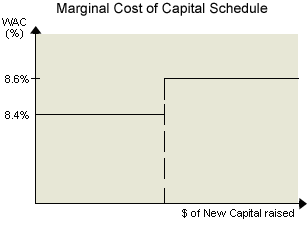CFA Level 1 - Corporate Finance
The marginal cost of capital (MCC) is the cost of the last dollar of capital raised, essentially the cost of another unit of capital raised. As more capital is raised, the marginal cost of capital rises.
With the weights and costs given in our previous example, we computed Newco's weighted average cost of capital as follows:
WACC = (wd)(kd)(1-t) + (wps)(kps) + (wce)(kce)
WACC = (0.4)(0.07)(1-0.4) + (0.05)(0.021) + (0.55)(0.12)
WACC = 0.084, or 8.4%
WACC = (0.4)(0.07)(1-0.4) + (0.05)(0.021) + (0.55)(0.12)
WACC = 0.084, or 8.4%
We originally determined the WACC for Newco to be 8.4%. Newco's cost of capital will remain unchanged as new debt, preferred stock and retained earnings are issued until the company's retained earnings are depleted.
Example:Marginal Cost of Capital
Once retained earnings are depleted, Newco decides to access the capital markets to raise new equity. As in our previous example for Newco, assume the company's stock is selling for $40, its expected ROE is 10%, next year's dividend is $2.00 and the company expects to pay out 30% of its earnings. Additionally, assume the company has a flotation cost of 5%. Newco's cost of new equity (kc) is thus 12.3%, as calculated below:
kc = 2 + 0.07 = 0.123, or 12.3%
40(1-0.05)
Answer:
Using this new cost of equity, we can determine the WACC as follows:
WACC = (wd)(kd)(1-t) + (wps)(kps) + (wce)(kce)
WACC = (0.4)(0.07)(1-0.4) + (0.05)(0.021) + (0.55)(0.123)
WACC = 0.086, or 8.6%The WACC has been stepped up from 8.4% to 8.6% given Newco's need to raise new equity.
Once retained earnings are depleted, Newco decides to access the capital markets to raise new equity. As in our previous example for Newco, assume the company's stock is selling for $40, its expected ROE is 10%, next year's dividend is $2.00 and the company expects to pay out 30% of its earnings. Additionally, assume the company has a flotation cost of 5%. Newco's cost of new equity (kc) is thus 12.3%, as calculated below:
kc = 2 + 0.07 = 0.123, or 12.3%
40(1-0.05)
Answer:
Using this new cost of equity, we can determine the WACC as follows:
WACC = (wd)(kd)(1-t) + (wps)(kps) + (wce)(kce)
WACC = (0.4)(0.07)(1-0.4) + (0.05)(0.021) + (0.55)(0.123)
WACC = 0.086, or 8.6%The WACC has been stepped up from 8.4% to 8.6% given Newco's need to raise new equity.
Figure 11.1


| Look Out! At some point, as the company continues to raise capital, the MCC can be higher than the WACC. |
MCC Vs. WACC
The marginal cost of capital is simply the weighted average cost of the last dollar of capital raised. As mentioned previously, in making capital decisions, a company keeps with a target capital structure. There comes a point, however, when retained earnings have been depleted and new common stock has to be used. When this occurs, the company's cost of capital increases. This is known as the "breakpoint" and can be calculated as follows:
Formula 11.9
The marginal cost of capital is simply the weighted average cost of the last dollar of capital raised. As mentioned previously, in making capital decisions, a company keeps with a target capital structure. There comes a point, however, when retained earnings have been depleted and new common stock has to be used. When this occurs, the company's cost of capital increases. This is known as the "breakpoint" and can be calculated as follows:
Formula 11.9
Breakpoint for retained earnings = retained earnings
wce
Example:
For Newco, assume we expect it to earn $50 million next year. As mentioned in our previous examples, Newco's payout ratio is 30%. What is Newco's breakpoint on the marginal cost curve, if we assume wce = 55%?
Answer:
Newco's breakpoint = $50 million (1-0.3) = $63.6 million
0.55
Thus, after Newco raises roughly $64 million of total capital, new common equity will need to be issued and Newco's WACC will increase to 8.6%.
Factors that affect the cost of capital can be categorized as those that are controlled by the company and those that are not.






0 comments:
Post a Comment